Basic Settings
In the following section, you will find out how to adjust changes to the behavior of the individual Knowledge functions.
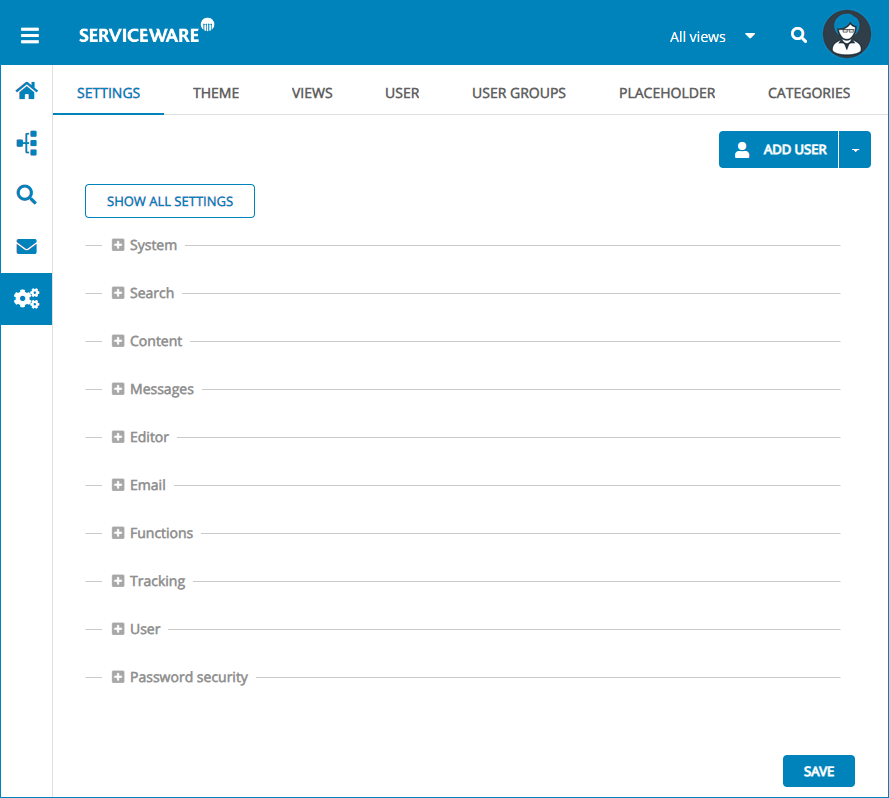
System
In the System area you will find general settings for Serviceware Knowledge.
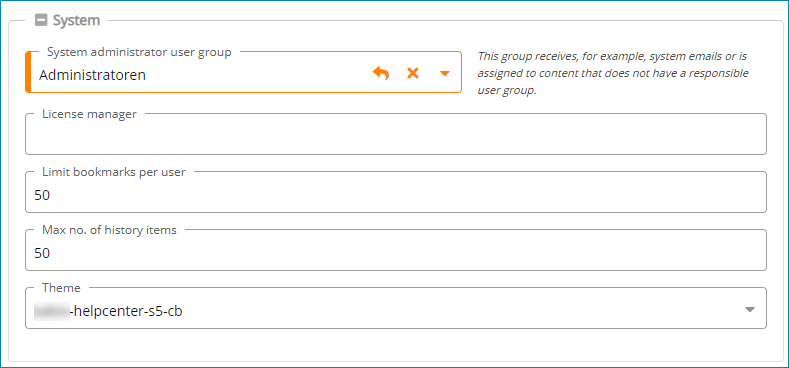
- System administrator user group
- From the drop-down list, select which of the existing user groups should be the system administrators' group.
- Licence manager
- This field is reserved for the Knowledge administrator.
- Limit bookmarks per user
- Define the maximum number of bookmarks that can be stored in the Bookmarks tab of each user.
- Maximum number of history items
- Define the maximum number of entries to be displayed in the list of history entries. History refers to the list of previously viewed content.
- Layout
- Select a layout from the drop-down list. This layout is used for the entire system, unless other layouts have been defined for individual views.
Search
You can define filters for the search function in the Search area.

From the list of available filters, select those you want to make available to your users.
Content
Configure appearance and behavior and other settings for the Knowledge content.
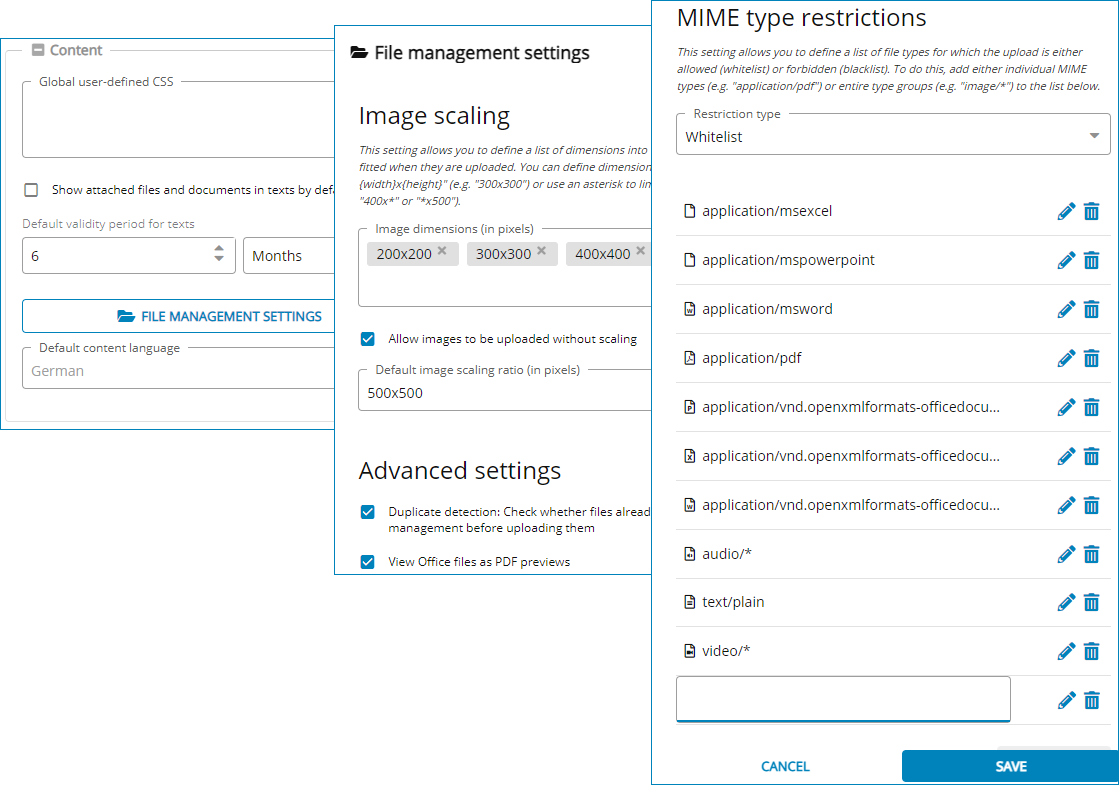
- Global user defined CSS
- Change parameters on the personal layout of your system, such as colors or fonts of certain elements, by entering CSS parameters. For an introduction to this topic, see https://www.w3.org/Style/CSS/.
- Show attached files and documents in text by default
- Select this option if you want links – if present – to be displayed in a separate area in all texts.
- Default validity period for texts
- Specify text validity periods in days, weeks or months. Select the system language from the drop-down list.
- File management settings
- Select this button to enter a file management configuration dialog.
- Image dimensions (in pixels)
- Define in pixels the sizes in which images can be displayed in texts. The dimensions defined here may be selected by the editorial team members in a drop-down list in the editor at a later stage.
- Allow images to be uploaded without scaling
- Allow the upload of images of any size.
- Default image scaling ratio (in pixel)
- Define the default size for images. If no size is selected, the image will be inserted at the default size.
- Duplicate detection: Before uploading, check whether files already exist in the file manager
- If you want duplicate detection, select the selection box.
- View Office files as PDF previews
- If Office files are not to be opened in the corresponding application but are to be displayed as a PDF preview, check the selection box.
- Default content language
- Select the language to which content is assigned by default if no other language is specified.
- Prioritisation of content language
- Specify the order in which languages are displayed in the tree.
Messages
Define the behavior of messages.
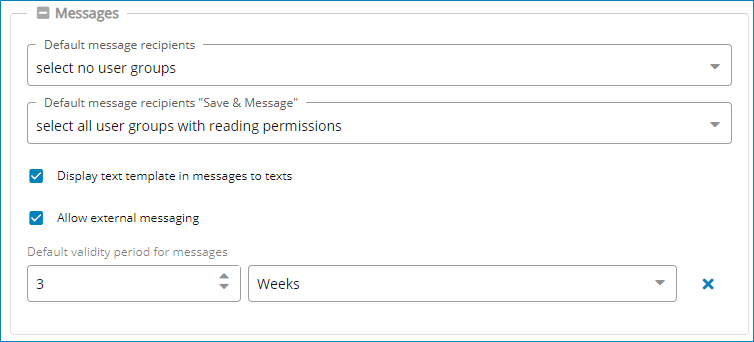
- Default message recipients
- Select whether you want to include all user groups or no user groups in the message distribution list.
- Default message recipients “save & message”
- Select whether you want to include all or no user groups with read permission in the message distribution list.
- Display text template in messages to texts
- If you want to offer text templates when creating messages for texts, activate the selection box.
- Allow external messaging
- If you want to allow the sending of messages to external contacts, activate the box.
- Defaul validity period for messages
- Select a period of time after which the message will be deleted from the recipients; set a value, then assign the unit in days, weeks or months.
Text editor
Select the settings for the editorial team members' work using the text editor.
The list of existing templates is shown in the upper part of the window. You can delete them or edit them via a dialog. In addition, you can save the changes via a dialog. Add new style You have to save the changes within the dialog each time.

- Add new style
- Design a new style sheet.
- Title
- Enter a title for the new style sheet.
- CSS class
- Enter a name for the CSS class.
- Font family
- Select a font from the list of available fonts.
- Size
- Select a font size in pixels (pt).
- Font color
- Define the text color via the dialog. You can set the color using sliders or specify it in HEX, RGB or HSV format.
- Style
- Select the highlighting type from the drop-down list.
- Type
- Choose the paragraph alignment, Inline or Block.
- Font family
- Choose the font for the default text of the Knowledge texts.
- Default font size
- Choose a font size in pixels (pt) for the default text of the Knowledge texts.
- Enable embedded video
- Activate or disable playing videos in Knowledge texts.
- Enable modern CKEditor
- Activate or disable the CKEditor.
- Activate editor functions
- Select the plug-ins you want to use for text composition from the list of supported plug-ins.
- Activate plug-ins not supported by Knowledge
- Note that these plug-ins may cause malfunctions.
Activate or disable the sending of attachments in emails.

- Emails with links
- activated: Attachments can be added to the emails.
Functions
Manage and activate additional functions.

- Deleting requires an additional user confirmation
- activated: Before deleting content in Knowledge, an additional dialog appears notifying you that a code must be entered for the content to be deleted.
- AI integration
- The functions which are set up with Artificial Intelligence (AI) support are shown here.
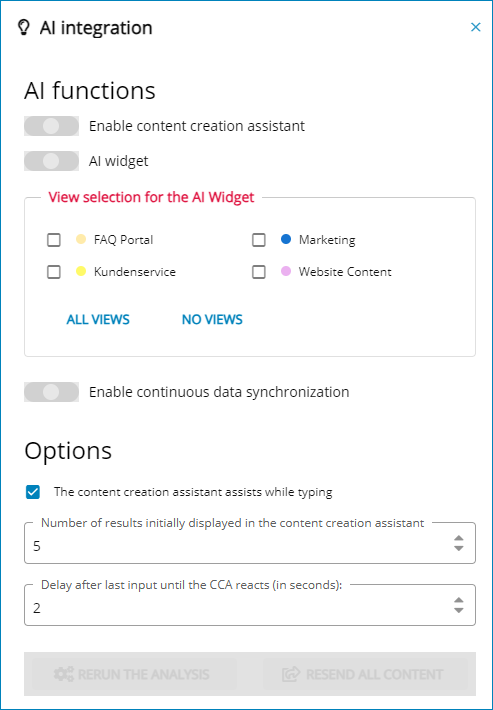
- Content creation assistant
- Once enabled, the content creation assistant actively suggests appropriate values for paths, categories, and tags.
- AI widget
- Activate the AI function for widgets.
- View selection for the AI widget
- Select the views you want to see in the AI widget. You can also set all views or none.
- Enable continuous data synchronization
- AIf you want to continuously synchronize data between the AI widget and the server, activate this function.
- The content createn assistant assists while typing
- If you want to be assisted by the content creation assistant while typing text, activate this function.
- Number of results initially displayed in the content creation assistant
- Decide how many results the content creation assistant should display in a list.
- Delay after last input until the cca reacts (in seconds)
- Enter a value in seconds after the last text input after which the CCA reacts.
- Templates
- Decide whether you want your editorial team to work with templates.
- Enable text block templates
- This function allows the editorial team to work with templates at text block level.
- Show messages in the top right corner
- Allow the display of messages in a field in the upper right-hand corner of the Knowledge screen.
Statistics
Enable the statistics function and activate tracking.
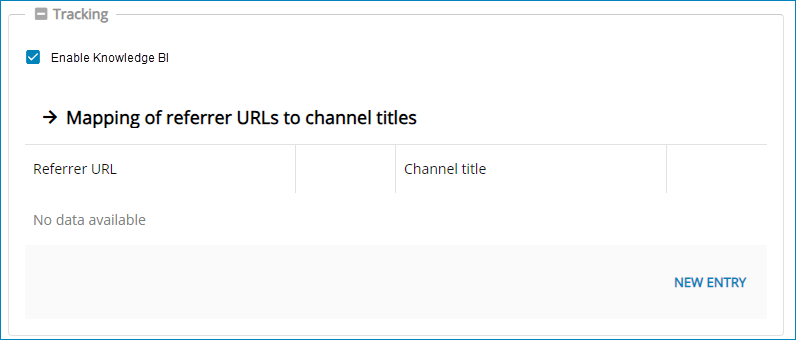
- Knowledge Activate BI
- Activate or disable the statistics function of Serviceware Knowledge.
- Mapping of referrer URLs to channel titles
- The URL of the website in which a widget is embedded is sent along in the referrer URL – the URL of the last page visited. For tracking to be traceable, define the name to which the referrer URL maps.
User
Define which actions are to be performed when a new user account is created.

- User email address is mandatory
- The system will not accept users unless an e-mail address is provided.
- Create contact on user creation
- When a new user is created, a contact is created at the same time. Contacts can be found and written to in the system.
- Enable standard view for users
- A default view is defined for the user.
Password security
Define the security of the passwords to be assigned in your system.
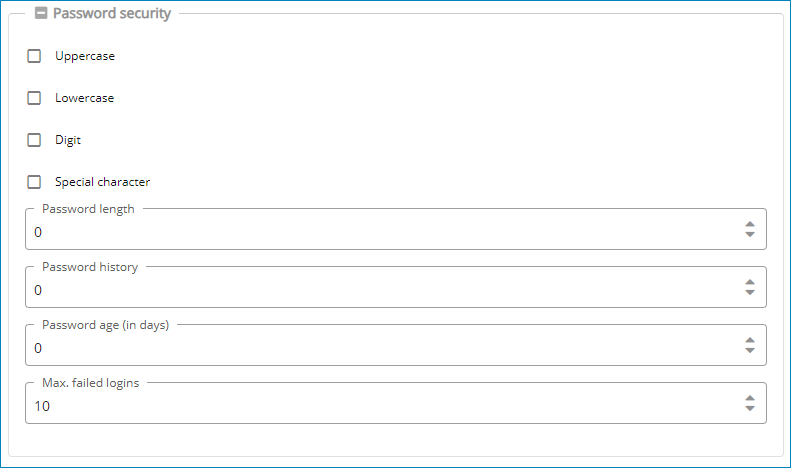
- Uppercase
- If this option is enabled, the chosen password must contain at least one upper-case letter.
- Lowercase
- If this option is enabled, the chosen password must contain at least one lower-case letter.
- Digit
- If this option is enabled, the chosen password must contain at least one number.
- Special character
- If this option is enabled, the selected password must contain at least one special character.
- Password length
- The number entered here defines the minimum length of the password in characters.
- Password history
- The number entered here defines the minimum number of different passwords that must be selected before a previously used password can be re-used.
- Password age
- The number entered here defines the period in days after which the set passwords will expire.
- Max. failed logins
-
The number entered here defines the number of incorrect log-ins after which a user account will be disabled.

